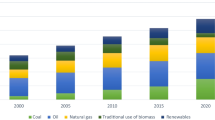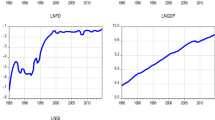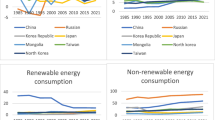Abstract
The study examined the dynamic nexus between carbon footprints, nonrenewable energy and renewable energy consumption, financial development and economic growth, and combating climate change by using a dataset of selected 13 Asian emerging economies (Bangladesh, China, India, Indonesia, Iran, Malaysia, Nepal, Pakistan, Philippines, South Korea, Sri Lanka, Thailand, and Vietnam) from 1995 to 2020. This study empirical analysis uses the second generation of panel cointegration techniques to compensate for cross-sectional dependency and slope heterogeneity. The mean group, the common correlated effects mean group, and the augmented mean group are used to estimate the long-run equations. The findings suggest that economic growth and nonrenewable energy consumption exacerbate environmental degradation, but renewable energy consumption mitigates the total adverse effects on the environment over time. Additionally, economy-specific findings examine how the impact of nonrenewable energy and renewable energy consumption on the carbon footprint depends on energy consumption level. Furthermore, the Dumitrescu-Hurlin causality test reveals a statistically significant bidirectional correlation between financial development, carbon footprints, economic growth, and consumption of nonrenewable energy and renewable energy. Finally, the study says that Asian emerging economies should use more renewable energy and be more efficient in order to reduce their carbon footprints.


Similar content being viewed by others
Data availability
The dataset used during the current study is available from the author on request.
Notes
British petroleum statistical review of world energy (BP) (2021a).
Global Footprint Network (GFN) (2021) Ecological footprint of countries.
Looney B (2020) Statistical Review of World Energy.
References
Ahmad A, Zhao Y, Shahbaz M et al (2016) Carbon emissions, energy consumption and economic growth: an aggregate and disaggregate analysis of the Indian economy. Energy Policy 96:131–143
Ajmi AN, Hammoudeh S, Nguyen DK, Sato JR (2015) On the relationships between CO2 emissions, energy consumption and income: the importance of time variation. Energy Econ 49:629–638
Ali G, Anbren S, Bashir MK (2018) Climate mitigation, low-carbon society, and dynamism of educational institutes in a low-income country. Environ Sci Pollut Res 25:3775–3784
Ali G, Abbas S, Qamer FM, Irteza SM (2021) Environmental spatial heterogeneity of the impacts of COVID-19 on the top-20 metropolitan cities of Asia-Pacific. Sci Rep 11:20339
Al-Mulali U, Saboori B, Ozturk I (2015) Investigating the environmental Kuznets curve hypothesis in Vietnam. Energy Policy 76:123–131
Alola AA, Bekun FV, Sarkodie SA (2019) Dynamic impact of trade policy, economic growth, fertility rate, renewable and non-renewable energy consumption on ecological footprint in Europe. Sci Total Environ 685:702–709
Alshehry AS, Belloumi M (2015) Energy consumption, carbon dioxide emissions and economic growth: the case of Saudi Arabia. Renew Sustain Energy Rev 41:237–247
Apergis N, Payne JE (2015) Renewable energy, output, carbon dioxide emissions, and oil prices: evidence from South America. Energy Sources Part B 10:281–287
Asumadu-Sarkodie S, Owusu PA (2017) The causal nexus between carbon dioxide emissions and agricultural ecosystem—an econometric approach. Environ Sci Pollut Res 24:1608–1618
Baek J (2016) Do nuclear and renewable energy improve the environment? Empirical evidence from the United States. Ecol Ind 66:352–356
Baloch MA, Mahmood N, Zhang JW (2019) Effect of natural resources, renewable energy and economic development on CO2 emissions in BRICS countries. Sci Total Environ 678:632–638
Baltagi BH, Feng Q, Kao C (2012) A Lagrange multiplier test for cross-sectional dependence in a fixed effects panel data model. J Econometr 170:164–177
Bao C, Xu M (2019) Cause and effect of renewable energy consumption on urbanization and economic growth in China’s provinces and regions. J Clean Prod 231:483–493
Bekhet HA, Othman NS (2017) Impact of urbanization growth on Malaysia CO2 emissions: evidence from the dynamic relationship. J Clean Prod 154:374–388
Belaid F, Zrelli MH (2019) Renewable and non-renewable electricity consumption, environmental degradation and economic development: evidence from Mediterranean countries. Energy Policy 133:110929
Bento JPC, Moutinho V (2016) CO2 emissions, non-renewable and renewable electricity production, economic growth, and international trade in Italy. Renew Sustain Energy Rev 55:142–155
Bhat JA (2018) Renewable and non-renewable energy consumption—impact on economic growth and CO 2 emissions in five emerging market economies. Environ Sci Pollut Res 25:35515–35530
Boontome P, Therdyothin A, Chontanawat J (2017) Investigating the causal relationship between non-renewable and renewable energy consumption, CO2 emissions and economic growth in Thailand. Energy Procedia 138:925–930
Breusch TS, Pagan AR (1980) The Lagrange multiplier test and its applications to model specification in econometrics. Rev Econ Stud 47:239–253
Cai Y, Sam CY, Chang T (2018) Nexus between clean energy consumption, economic growth and CO2 emissions. J Clean Prod 182:1001–1011
Chen Y, Wang Z, Zhong Z (2019) CO2 emissions, economic growth, renewable and non-renewable energy production and foreign trade in China. Renew Energy 131:208–216
Choi I (2001) Unit root tests for panel data. J Int Money Financ 20:249–272
Destek MA, Sinha A (2020) Renewable, non-renewable energy consumption, economic growth, trade openness and ecological footprint: evidence from organisation for economic Co-operation and development countries. J Clean Prod 242:118537
Dogan E, Seker F (2016) The influence of real output, renewable and non-renewable energy, trade and financial development on carbon emissions in the top renewable energy countries. Renew Sustain Energy Rev 60:1074–1085
Dogan E, Turkekul B (2016) CO2 emissions, real output, energy consumption, trade, urbanization and financial development: testing the EKC hypothesis for the USA. Environ Sci Pollut Res 23:1203–1213
Dogan E, Taspinar N, Gokmenoglu KK (2019) Determinants of ecological footprint in MINT countries. Energy Environ 30:1065–1086
Dumitrescu E-I, Hurlin C (2012) Testing for Granger non-causality in heterogeneous panels. Econ Model 29:1450–1460
Eberhardt M, Bond S (2009) Cross-section dependence in nonstationary panel models: a novel estimator. Munich Personal RePEc Archive Working Paper No. 17692. https://mpra.ub.uni-muenchen.de/id/eprint/17692
Emir F, Bekun FV (2019) Energy intensity, carbon emissions, renewable energy, and economic growth nexus: new insights from Romania. Energy Environ 30:427–443
Fang Z, Gao X, Sun C (2020) Do financial development, urbanization and trade affect environmental quality? Evidence from China. J Clean Prod 259:120892
Farhani S, Shahbaz M (2014) What role of renewable and non-renewable electricity consumption and output is needed to initially mitigate CO2 emissions in MENA region? Renew Sustain Energy Rev 40:80–90
Gao J, Yuan Z, Liu X et al (2016) Improving air pollution control policy in China—a perspective based on cost–benefit analysis. Sci Total Environ 543:307–314
Huang J, Liu Y, Hou H, You T (2008) Simultaneous electrochemical determination of dopamine, uric acid and ascorbic acid using palladium nanoparticle-loaded carbon nanofibers modified electrode. Biosens Bioelectron 24:632–637
Hussain J, Pan Y, Ali G, Xiaofang Y (2020) Pricing behavior of monopoly market with the implementation of green technology decision under emission reduction subsidy policy. Sci Total Environ 709:136110
Isman M, Archambault M, Racette P et al (2018) Ecological footprint assessment for targeting climate change mitigation in cities: a case study of 15 Canadian cities according to census metropolitan areas. J Clean Prod 174:1032–1043
Ito K (2017) CO2 emissions, renewable and non-renewable energy consumption, and economic growth: evidence from panel data for developing countries. Int Econ 151:1–6
Jebli MB, Youssef SB, Ozturk I (2016) Testing environmental Kuznets curve hypothesis: the role of renewable and non-renewable energy consumption and trade in OECD countries. Ecol Indic 60:824–831
Kamyab S, Ataei SA, Tabatabaee M, Mirhosseinei SA (2019) Optimization of bio-hydrogen production in dark fermentation using activated sludge and date syrup as inexpensive substrate. Int J Green Energy 16:763–769
Kasman A, Duman YS (2015) CO2 emissions, economic growth, energy consumption, trade and urbanization in new EU member and candidate countries: a panel data analysis. Econ Model 44:97–103
Katircioglu S (2022) Estimating the role of urban development in environment quality: evidence from G7 countries. Energy Environ 33:283–314
Katircioglu S, Katircioglu S (2018) Testing the role of fiscal policy in the environmental degradation: the case of Turkey. Environ Sci Pollut Res 25:5616–5630
Katircioglu S, Katircioglu S, Kilinc CC (2018) Investigating the role of urban development in the conventional environmental Kuznets curve: evidence from the globe. Environ Sci Pollut Res 25:15029–15035
Katircioğlu S, Katircioğlu S (2018) Testing the role of urban development in the conventional environmental Kuznets curve: evidence from Turkey. Appl Econ Lett 25:741–746
Khalid K, Usman M, Mehdi MA (2021) The determinants of environmental quality in the SAARC region: a spatial heterogeneous panel data approach. Environ Sci Pollut Res 28:6422–6436
Khan MK, Teng J-Z, Khan MI, Khan MO (2019a) Impact of globalization, economic factors and energy consumption on CO2 emissions in Pakistan. Sci Total Environ 688:424–436
Khan MTI, Yaseen MR, Ali Q (2019b) Nexus between financial development, tourism, renewable energy, and greenhouse gas emission in high-income countries: a continent-wise analysis. Energy Econ 83:293–310
Köksal C, Işik M, Katircioğlu S (2020) The role of shadow economies in ecological footprint quality: empirical evidence from Turkey. Environ Sci Pollut Res 27:13457–13466
Köksal C, Katircioglu S, Katircioglu S (2021) The role of financial efficiency in renewable energy demand: evidence from OECD countries. J Environ Manag 285:112122
Kong Y, Khan R (2019) To examine environmental pollution by economic growth and their impact in an environmental Kuznets curve (EKC) among developed and developing countries. PLoS ONE 14:e0209532. https://doi.org/10.1371/journal.pone.0209532
Kouhizadeh M, Zhu Q, Sarkis J (2020) Blockchain and the circular economy: potential tensions and critical reflections from practice. Prod Plan Contr 31:950–966
Le T-H, Quah E (2018) Income level and the emissions, energy, and growth nexus: evidence from Asia and the Pacific. Int Econ 156:193–205
le Quéré C, Jackson RB, Jones MW et al (2020) Temporary reduction in daily global CO2 emissions during the COVID-19 forced confinement. Nat Clim Chang 10:647–653
Lee C-C, Chang C-P (2008) Energy consumption and economic growth in Asian economies: a more comprehensive analysis using panel data. Resour Energy Econ 30:50–65
Liu X, Zhang S, Bae J (2017) The nexus of renewable energy-agriculture-environment in BRICS. Appl Energy 204:489–496
Lutz W, Butz WP, Samir KC (2017) World population & human capital in the twenty-first century: an overview
Maddala GS, Wu S (1999) A comparative study of unit root tests with panel data and a new simple test. Oxford Bull Econ Stat 61:631–652
Magazzino C (2015) Energy consumption and GDP in Italy: cointegration and causality analysis. Environ Dev Sustain 17:137–153
Mishra A, Basu S, Shetti NP, Reddy KR (2019) Metal oxide nanohybrids-based low-temperature sensors for NO2 detection: a short review. J Mater Sci: Mater Electron 30:8160–8170
Nasreen S, Anwar S, Ozturk I (2017) Financial stability, energy consumption and environmental quality: evidence from South Asian economies. Renew Sustain Energy Rev 67:1105–1122
Nassani AA, Aldakhil AM, Abro MMQ, Zaman K (2017) Environmental Kuznets curve among BRICS countries: spot lightening finance, transport, energy and growth factors. J Clean Prod 154:474–487
Nathaniel SP, Iheonu CO (2019) Carbon dioxide abatement in Africa: the role of renewable and non-renewable energy consumption. Sci Total Environ 679:337–345
Global Footprint Network, GFN (2021) http://data.footprintnetwork.org/. Accessed 9 Nov 2021
Nguyen KH, Kakinaka M (2019) Renewable energy consumption, carbon emissions, and development stages: some evidence from panel cointegration analysis. Renew Energy 132:1049–1057
Owusu PA, Asumadu-Sarkodie S (2016) A review of renewable energy sources, sustainability issues and climate change mitigation. Cogent Eng 3:1167990
Pesaran MH (2021) General diagnostic tests for cross-sectional dependence in panels. Empir Econ 60:13–50
Rafindadi AA, Ozturk I (2017) Impacts of renewable energy consumption on the German economic growth: evidence from combined cointegration test. Renew Sustain Energy Rev 75:1130–1141
Rauf A, Liu X, Amin W et al (2018) Testing EKC hypothesis with energy and sustainable development challenges: a fresh evidence from belt and road initiative economies. Environ Sci Pollut Res 25:32066–32080
Sabir S, Gorus MS (2019) The impact of globalization on ecological footprint: empirical evidence from the South Asian countries. Environ Sci Pollut Res 26:33387–33398
Saboori B, Rasoulinezhad E, Sung J (2017) The nexus of oil consumption, CO2 emissions and economic growth in China, Japan and South Korea. Environ Sci Pollut Res 24:7436–7455
Sadorsky P (2010) The impact of financial development on energy consumption in emerging economies. Energy Policy 38:2528–2535
Saidi K, Mbarek MB (2016) Nuclear energy, renewable energy, CO2 emissions, and economic growth for nine developed countries: evidence from panel Granger causality tests. Prog Nucl Energy 88:364–374
Salahuddin M, Habib MA, Al-Mulali U et al (2020) Renewable energy and environmental quality: a second-generation panel evidence from the Sub Saharan Africa (SSA) countries. Environ Res 191:110094
Saqib N (2021) Energy consumption and economic growth: empirical evidence from MENA region. Int J Energy Econ Policy 11:191
Sarkodie SA, Adams S (2018) Renewable energy, nuclear energy, and environmental pollution: accounting for political institutional quality in South Africa. Sci Total Environ 643:1590–1601
Şenhaz Z, Katircioglu S, Katircioglu S (2021) Dynamic effects of shadow economy and environmental pollution on the energy stock prices: empirical evidence from OECD countries. Environ Sci Pollut Res 28:8520–8529
Shahbaz M, Lean HH, Shabbir MS (2012) Environmental Kuznets curve hypothesis in Pakistan: cointegration and Granger causality. Renew Sustain Energy Rev 16:2947–2953
Sugiawan Y, Managi S (2016) The environmental Kuznets curve in Indonesia: exploring the potential of renewable energy. Energy Policy 98:187–198
Sulaiman C, Abdul-Rahim AS (2017) The relationship between CO2 emission, energy consumption and economic growth in Malaysia: a three-way linkage approach. Environ Sci Pollut Res 24:25204–25220
Tahir T, Luni T, Majeed MT, Zafar A (2021) The impact of financial development and globalization on environmental quality: evidence from South Asian economies. Environ Sci Pollut Res 28:8088–8101
Tang CF, Tan BW (2015) The impact of energy consumption, income and foreign direct investment on carbon dioxide emissions in Vietnam. Energy 79:447–454
Tuna G, Tuna VE (2019) The asymmetric causal relationship between renewable and non-renewable energy consumption and economic growth in the ASEAN-5 countries. Resour Policy 62:114–124
Turhal S, Turanbaev M, Argun H (2019) Hydrogen production from melon and watermelon mixture by dark fermentation. Int J Hydrog Energy 44:18811–18817
Ulucak R, Bilgili F (2018) A reinvestigation of EKC model by ecological footprint measurement for high, middle and low income countries. J Clean Prod 188:144–157
Usman M, Kousar R, Yaseen MR, Makhdum MSA (2020) An empirical nexus between economic growth, energy utilization, trade policy, and ecological footprint: a continent-wise comparison in upper-middle-income countries. Environ Sci Pollut Res 27:38995–39018
Waheed R, Chang D, Sarwar S, Chen W (2018) Forest, agriculture, renewable energy, and CO2 emission. J Clean Prod 172:4231–4238
Wang J, Dong K (2019) What drives environmental degradation? Evidence from 14 Sub-Saharan African countries. Sci Total Environ 656:165–173
Westerlund J (2007a) Testing for error correction in panel data. Oxford Bull Econ Stat 69:709–748
Xu T (2018) Investigating environmental Kuznets curve in China–aggregation bias and policy implications. Energy Policy 114:315–322
Xu B, Chen D, Venkateshkumar M et al (2019) Modeling a pumped storage hydropower integrated to a hybrid power system with solar-wind power and its stability analysis. Appl Energy 248:446–462
Yan X, Cui S, Xu L et al (2018) Carbon footprints of urban residential buildings: a household survey-based approach. Sustainability 10:1131
Yavuz NÇ (2014) CO2 emission, energy consumption, and economic growth for Turkey: evidence from a cointegration test with a structural break. Energy Sources Part B 9:229–235
Yu L, Yıldız İ (2018) 1.24 energy and water pollution
Zafar MW, Shahbaz M, Hou F, Sinha A (2019) From nonrenewable to renewable energy and its impact on economic growth: the role of research & development expenditures in Asia-Pacific Economic Cooperation countries. J Clean Prod 212:1166–1178
Zaidi SAH, Hou F, Mirza FM (2018) The role of renewable and non-renewable energy consumption in CO2 emissions: a disaggregate analysis of Pakistan. Environ Sci Pollut Res 25:31616–31629
Zhang X, Chen L, Yuan R (2020) Effect of natural and anthropic factors on the spatiotemporal pattern of haze pollution control of China. J Clean Prod 251:119531
Acknowledgements
I would like to thank Prince Sultan University for their support.
Author information
Authors and Affiliations
Contributions
Not applicable.
Corresponding author
Ethics declarations
Ethics approval and consent to participate
Not applicable.
Consent for publication
Not applicable.
Competing interests
The author declares no competing interests.
Additional information
Responsible Editor: Roula Inglesi-Lotz
Publisher's note
Springer Nature remains neutral with regard to jurisdictional claims in published maps and institutional affiliations.
Rights and permissions
About this article
Cite this article
Saqib, N. Nexus between the renewable and nonrenewable energy consumption and carbon footprints: evidence from Asian emerging economies. Environ Sci Pollut Res 29, 58326–58340 (2022). https://doi.org/10.1007/s11356-022-19948-8
Received:
Accepted:
Published:
Issue Date:
DOI: https://doi.org/10.1007/s11356-022-19948-8




